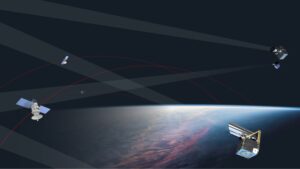NorthStar orders three satellites to collect space situational awareness data
By Jeff Foust

WASHINGTON — NorthStar Earth and Space, a Canadian company planning a satellite constellation to track other satellites, has selected Thales Alenia Space to build its first satellites.
Montréal-based NorthStar announced Oct. 27 that Thales will build its first three Skylark satellites, working in conjunction with LeoStella, its smallsat manufacturing joint venture with BlackSky. The satellites, based on LeoStella’s LEO-100 bus and assembled at its factory near Seattle, are scheduled for launch in 2022. The companies did not disclose terms of the satellite contract.
Each satellite, operating in a polar orbit at an altitude of 575 kilometers, will carry an optical payload that will scan orbits ranging from low Earth orbit to geostationary orbit to track satellites. NorthStar plans to use those observations to provide customers with space situational awareness (SSA) services.
NorthStar has been working on this concept for several years, originally pitching it as a dual-use system, with satellites also carrying hyperspectral sensors for Earth observation. The Skylark satellites, though, will be devoted to SSA.
“We’ve convinced ourselves that we’re in a good place with clients, with our partners, with our manufacturing plant. It’s time to start building the satellites and start getting the services up and running,” Stewart Bain, chief executive of NorthStar, said in an interview.
The three satellites ordered now are the beginning of a constellation of at least 12 NorthStar plans to launch by 2024. Bain said the company will launch them three at a time into different orbital planes to enhance its coverage.
NorthStar is entering an increasingly crowded market for SSA and related services. Companies like ExoAnalytics and LeoLabs already provide SSA data using ground-based telescopes and radars, and use that data to provide services for satellite operators and other customers. Others, like AGI’s Commercial Space Operations Center, take data from a variety of sources to provide space traffic management services.
Bain said that NorthStar’s key difference is that its data will come from satellites. “The perspective of space gives you high revisit on objects, and filling out the whole view of space and everything that is going on in space is done in a matter of hours,” he claimed. “Because we’re in space we’re not limited by atmosphere and weather.”
He declined to specify how small of an object that the system will be able to track other than it will be able to see those that are “multiple centimeter sized.” The newest radars operated by LeoLabs can track objects as small as two centimeters across in LEO, the company has stated.
Bain expects the service to win business from both commercial and government organizations. That includes the U.S. Office of Space Commerce, which is tasked with space traffic management responsibilities and is working on what it calls an “open architecture data repository” that will combine SSA data from a variety of sources. “We’re very motivated to support the U.S.’s endeavors in space traffic management and provide them with necessary information to do that,” he said.
NorthStar raised $65 million in 2018, and Bain said the company’s current funding is sufficient to start work on the Skylark system. The company declined to discuss any ongoing fundraising efforts, citing restrictions in Canadian law.
While the initial satellites are focused on SSA, NorthStar has not ruled out pursuing Earth observation, part of its original plans, in the future. Hyperspectral imagers, Bain said, would require far more capital to develop, hence the initial focus on SSA. “Raising the capital necessary for 40 satellites with hyperspectral imagers is a much bigger challenge.”
“Launching the SSA system allows us to become a revenue generating enterprise rather than just a startup,” he said. “We felt the right focus was to get the Skylark system up and running, be the first in space, deliver the services. There is a demand for that right now.”
October 27, 2020 at 07:48PM
via SpaceNews read more...

Post a Comment